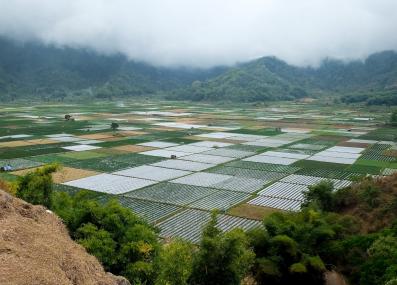New to Climate Change?
The National Climate Assessment
The National Climate Assessment (NCA) is the U.S. government’s preeminent report on climate change in the United States. It is produced by the U.S. Global Change Research Program (USGCRP), a federal program of 15 agencies charged with delivering a quadrennial assessment that a) integrates, evaluates, and interprets the findings of the Program and discusses the scientific uncertainties associated with such findings; b) analyzes the effects of global change on eight specific sectors; and c) analyzes current trends in global change, both human-caused and natural, and projects major trends for the next 25 to 100 years.1
Five NCAs have been produced since 2001, and the structure and development of each has evolved over time to reflect feedback from the federal agencies and the public.
Key sectors
Every NCA must address the ways climate change relates to these topics in the United States:
Natural environment
Agriculture
Energy production and use
Land and water resources
Transportation
Human health and welfare
Human social systems
Biological diversity
What's in the Fifth National Climate Assessment?
The most recent assessment, NCA5, was released in 2023. The report lays out the basic science of climate change, examines how climate change will affect 17 national-level topics, and includes 10 regional chapters covering the entire United States. The report also dedicates two chapters to climate change response through adaptation and mitigation, as well as five focus boxes on cross-cutting issues, including COVID-19, supply chains, blue carbon, compound events, and western wildfire.
The NCA gives close attention to current and future risks, how those risks can be reduced, and implications for society under different future scenarios. It draws on the downscaled data made available in the NCA Atlas, which lets Americans explore the impacts of climate change in their own backyards.
The findings of NCA5 were informed by thousands of pieces of scientific literature, building on the foundation of the Fourth National Climate Assessment, as well as technical sources like the 2022 Sea Level Rise Technical Report, NOAA’s State Climate Summaries, and the Climate Resilience Toolkit. For NCA5, USGCRP made a special effort to fill data gaps for regions outside the contiguous U.S., including Alaska, Hawaiʻi and the U.S.-Affiliated Pacific Islands, Puerto Rico, and the U.S. Virgin Islands.
For the first time, NCA5 includes chapters on Economics and Social Systems and Justice, which were added in response to public input early in the report’s development. These chapters cover topics such as climate change impacts on the U.S. economy, markets and budgets, equity, and climate justice. The report also includes a new appendix dedicated to climate change indicators, as well as an updated and extensive glossary of terms.
In addition to the scientific advances, NCA5 includes new efforts to expand the reach and resonance of the report and move people to greater understanding of climate change. NCA5 features the Art x Climate gallery showcasing works by 92 artists, as well as an opening poem by Poet Laureate Ada Limón and a companion podcast series featuring NCA5 authors and staff.
National Climate Assessments synthesize scientific information and evaluate the state of the science on climate change to inform a broad audience of decision-makers across the country… to describe what we know and where uncertainties remain, and to clearly communicate the risks, responses, and opportunities associated with climate change.
- Introduction to the Fifth National Climate Assessment
How is the National Climate Assessment written?
NCA5 was written by 500 authors and 260 technical contributors from every state in the nation as well as Puerto Rico, the U.S. Virgin Islands, Guam, and Palau.2 Author teams include federal scientists, academics, and practitioners from a range of sectors. To make sure NCA5 is useful to its audiences, report authors did extensive public outreach, including a series of public engagement workshops and several calls for written comment.
The findings of the NCA are made transparent through: (1) the use of a chapter structure designed to explicitly address confidence and uncertainty; (2) multiple stages of review by federal scientists, the public, and the National Academies of Sciences, Engineering, and Medicine; and (3) the Global Change Information System (GCIS), which lets readers trace figure data and learn more about source information. More about the NCA5 process is available here.
Updated December 7, 2023.
1 U.S. Global Change Research Program: About USGCRP.
2 U.S. Global Change Research Program: Fifth National Climate Assessment. Report Credits. Crimmins, A.R., C.W. Avery, D.R. Easterling, K.E. Kunkel, B.C. Stewart, and T.K. Maycock, Eds. U.S. Global Change Research Program, Washington, DC, USA, doi:10.7930/NCA5.2023.







